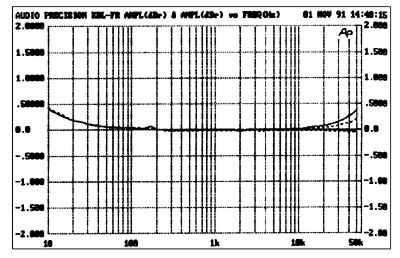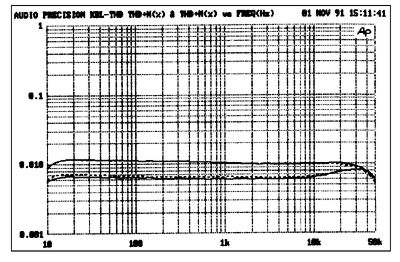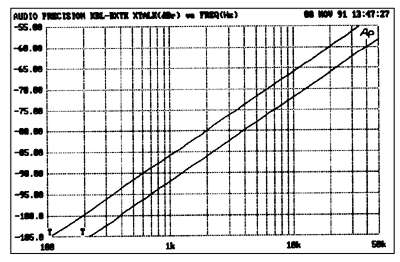| Columns Retired Columns & Blogs |
Krell KBL preamplifier Measurements
Sidebar 3: Measurements (from April 1992, Vol.15 No.4)
Footnote 1: This recommendation was crystalized in AES and American National Standard AES14-1992 (ANSI S4.48-1992), "AES Standard for professional audio equipment—Application of connectors, part 1, XLR-type polarity and gender," published in the JAES, Vol.40 No.1-2, January-February 1992.—John Atkinson
The line-stage-only KBL used in its balanced input/balanced output mode had an output impedance of under 4 ohms at any setting of the level control. Its balanced input impedance for either channel varied between 66.5k ohms and 73.9k ohms, with the higher values at the lower settings of the level control. In the unbalanced mode (input and output) the output impedance measured under 2.2 ohms at any setting of the level control (including interconnects), and the input impedance measured between 45.2k ohms and 49k ohms at various level settings. The tape monitor output impedance measured just under 50 ohms regardless of source impedance, indicating buffering on the tape outputs.
Unity gain was with the volume control set to approximately 12:30 (balanced) and 2:00 (unbalanced). Gain in the balanced position measured 14.4dB (high-gain position) or 8.6dB (low-gain). Unbalanced gain measured 8.4dB (high-gain) or 2.57dB (low). The KBL was non-inverting through either balanced or unbalanced outputs (Note, however, that Krell uses the convention of pin 2 positive in the balanced XLR connectors, footnote 1). DC offset measured an excellent 0.5mV from the left channel, but 8.7mV from the right. A second sample was okay, however.
Fig.1 shows the Krell's frequency response with the level control set at full (lower traces—solid is left, dotted right in all cases) and 9:00 (upper curves). The implication is that the preamp develops a well-damped ultrasonic peak with the volume control turned down. In fig.2, the THD+noise for the unbalanced connection is shown in the lower trace, the balanced in the upper. Note that the distortion for the balanced is slightly higher, which can occur due to a very slight gain mismatch in the positive and negative halves of the balanced circuit.

Fig.1 Krell KBL, frequency response with volume control full (flat traces) and at 9 o'clock (top traces above 10kHz) (0.5dB/vertical div., right channel dashed).

Fig.2 Krell KBL, THD+noise (%) vs frequency in unbalanced (bottom) and balanced modes (top) (right channel dashed).
The separation of the KBL in the balanced mode is indicated in fig.3. The bottom trace is the crosstalk from left to right, the top from right to left. (The unbalanced crosstalk was virtually identical.—Thomas J. Norton

Fig.3 Krell KBL, channel separation in balanced mode, L-R (bottom) and R-L (top) (10dB/vertical div.).
Footnote 1: This recommendation was crystalized in AES and American National Standard AES14-1992 (ANSI S4.48-1992), "AES Standard for professional audio equipment—Application of connectors, part 1, XLR-type polarity and gender," published in the JAES, Vol.40 No.1-2, January-February 1992.—John Atkinson
- Log in or register to post comments




































